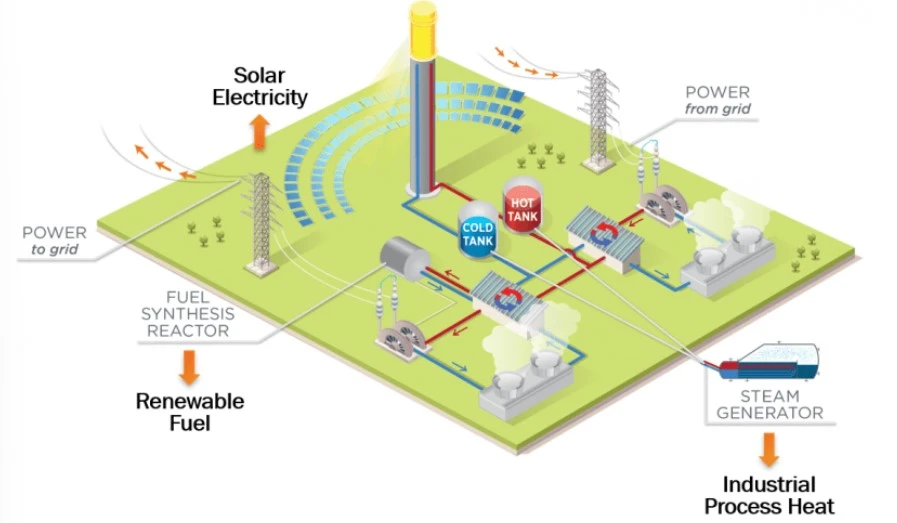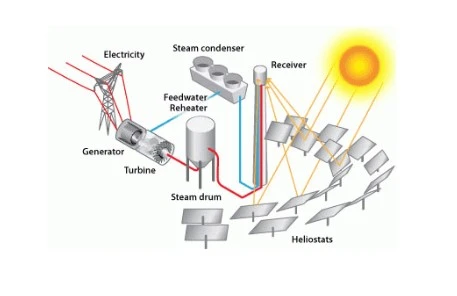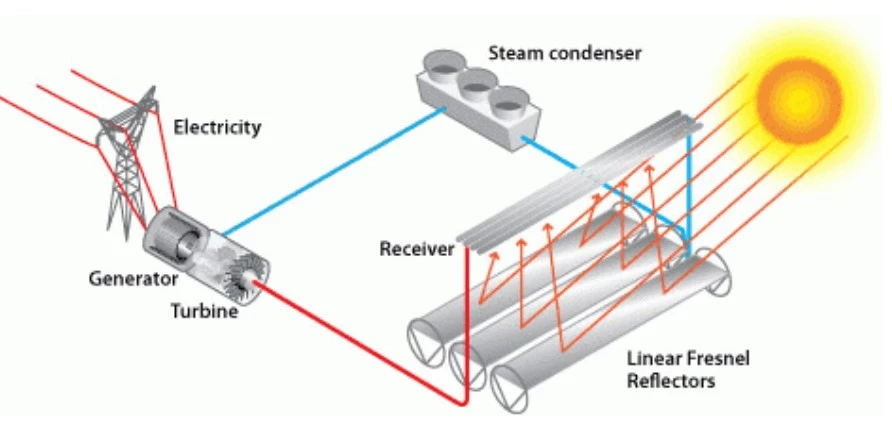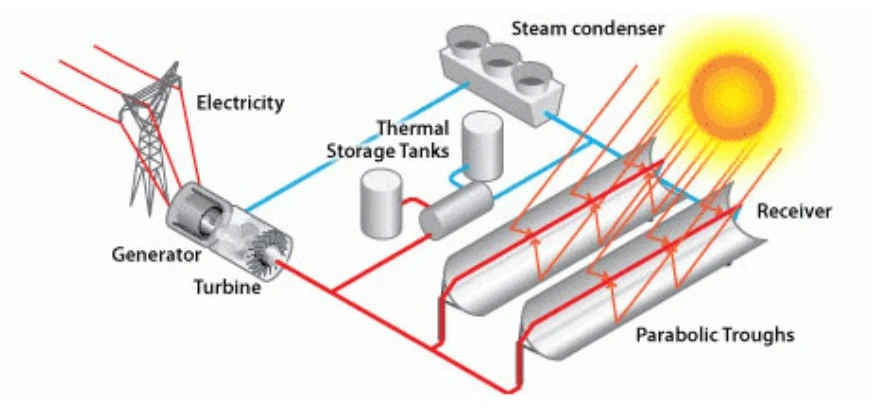Table of Contents
Concentrated Solar Power focuses a large amount of sunlight onto a receiver using mirrors (lenses). This process helps produce heat that will be used to generate electricity. Excess heat produced is usually stored in a thermal storage system. This feature is called dispatchability and is highly used in cloudy or rainy weather conditions.
Both concentrated solar power and concentrated solar thermal power are effective methods of harnessing sustainable renewable energy through natural resources.
How Does a Concentrated Solar Power Plant Work?
The Concentrated Solar Power systems undergo a series of steps to generate clean electricity using concentrated sunlight. The steps are explained in detail as follows:

Sunlight Concentration
The Concentrated solar plant focuses the sunlight on a large scale using mirrors and lenses onto a receiver. These vast solar panels and lenses are strategically placed to reflect concentrated sunlight onto the receiver.
Find Concentrated Solar Power Projects and Tenders in India Claim your Free leads!
Heating Transfer Fluid
The receiver filled with transfer fluid starts heating up due to the hot spot created by the concentrated sunlight. This hot spot heats the fluid to more than 100 degrees Celsius thus acting as a heat carrier later used for boiling large volumes of water for steam production.
Steam Generation
The transfer fluid after heated travels through a heat exchanger to boil water at high temperatures. This leads to generating high-pressure steam. This high-level steam, also referred to as thermal energy, can be used for several applications such as water desalination, food processing, enhanced oil recovery, and mineral processing.
Electricity is Produced
The huge volumes of steam produced are further moved through large turbines such as windfarms projects thus converting the thermal energy (steam) into clean electricity.
Also Read: India Becomes the Third Largest Solar Power Producer in the World
Thermal Storage System
The Thermal heat storage system helps CSP generate electricity even without collecting sunshine during rainy or cloudy weather conditions. This technology is widely used in central receiver towers where higher operating temperatures translate to greater energy yield.
Research has been made to improvise existing technologies to increase potential and significantly reduce costs. This includes the exploration of thermochemical reactions, which store solar energy in chemical bonds. While molten salt is a common storage medium, it can be expensive. Alternative options include storing heat in materials like sulfur or solid particles, offering a wider range of possibilities for future CSP technology development.
Concentrated Solar Thermal Power
Concentrated Solar Thermal Power is produced using stored heat from the thermal storage system which is passed through a heat exchanger to create high-pressure steam. This steam spins turbines to generate electricity. This dispatchability feature helps generate electricity during cloudy and rainy weather conditions, making it a reliable renewable energy source compared to traditional solar panels.
Types of Concentrated Solar Power Technologies
Concentrated solar power systems are used for utility-scale projects. There are four different types of concentrated solar PV technologies listed below:
Power Tower Systems
In the Solar Power Tower system, the sonal panels known as heliostats are strategically placed to concentrate sunlight onto the top of the center tower. This tower is located in the center of the field with its receiver located at the top. The mirrors focus the sunlight onto the receiver at the top heating the transfer fluid and pushing the steam towards the down of the tower thus, generating solar thermal energy and electricity.

Dish/Engine Systems
The dish/engine systems use parabolic solar panels focusing light on the central engine in the field that produces electricity. It is similar to that of the power tower system, however, the dish/engine system produces a low amount of electricity that ranges from 3 to 25 kilowatts. This makes it efficient for modular use. This includes two major parts: a solar concentrator and a power conversion unit.
Solar Concentrator
The solar concentrator or dish collects sunlight to create a beam of concentrated sunlight onto the thermal receiver to generate thermal energy. This energy is used for power generation and to produce electricity. The dishes are high-mounted onto a structure to track the sunlight movement and collect maximum sunlight.
Power Conversion Unit
The power conversion unit includes an athermal receiver and engine generator. The thermal receiver acts as an interface that supplies heat to the engine/generator system. The thermal receiver can be in the form of collective tubes with a cooling fluid or heat pipes. Similarly, the engine/generator system acts as a subsystem that receives thermal heat and produces electricity.
Linear Concentrating Solar Power
Linear concentrating solar power collects sunlight through its large number of parallelly arranged collectors that collect the sunlight and focus onto the receiver tubes. The linear systems include thermal storage that collects sunlight and stores excess steam to produce electricity during cloudy and rainy seasons.

Parabolic Trough Systems
The Parabolic trough CSP system uses parabolic-shaped collectors focusing on the receiver tube arranged on the focal line of these reflectors. This receiver tube is connected to the mirrors where the transfer fluid flows thus collecting heat from these solar mirrors which is later used to produce steam.

Linear Fresnel Systems
In the Linear fresnel system, the mirrors are arranged in lines around the parallel tubes arranged in front of these mirrors. These mirrors are slightly curved to act as reflectors and focus the sunlight onto these parallel tubes. These parallel tubes consist of the heat transfer fluid that heats up due to focused sunlight thus, generating steam and electricity.
Also Read: What are Floating Solar Photovoltaic Power Plants? How does it work?
Global Leaders in Concentrated Solar Power Projects
Several countries contributed to the development of Concentrated solar power plants in their country by investing in pilot CSP projects. Below is the list of a few countries and their contributions:
Morocco
Morocco is a global leader in the concentrated solar power (CSP) industry achieving its ambitious target of generating 42% of its electricity from renewables by 2020. This commitment extends to the future, to reach 52% by 2030, requiring an additional 6 GW of capacity (MASEN 2020).
The Noor Ouarzazate complex is one of the world's largest operating CSP plants. This complex facility combines 510 MW of CSP with a 72 MW photovoltaic (PV) plant.
UAE
The UAE (United Arab Emirates) is another key player recognizing the need for clean energy solutions with a target of deploying 2.7 GW of clean energy by 2021 (a goal they recently surpassed with the inauguration of the world's largest CSP project in December 2023).
China
The National Energy Administration of China launched its first batch of CSP pilot projects in 2016. This initiative involved selecting 20 projects with a combined capacity of 1.3 GW. This pilot program attracted several investments and developments in the CSP industry.
United States
In the 1980s, state-level renewable portfolio standards (RPS) and federal incentives like investment tax credits and loan guarantees were introduced which helped the growth of the CSP industry in the United States.
Benefits of Concentrated Solar Power Plants
Concentrated solar power plants are a major source of green energy and serve several benefits as follows:
- Most Efficient Renewable Energy Source: The primary input is sunlight to produce electricity. Sunlight is the world’s most abundant renewable energy source.
- Scalability: Concentrated Solar Power allows the flexibility to set up small and large-scale plants additionally excess electricity produced can be integrated with a grid for renewable energy.
- Extended Lifespan: The CSP plant projects installed serve up to 25 years with efficiency. This makes them a reliable source of sustainable energy.
- Sustainable Energy Storage: Their thermal storage helps to store sustainable energy without any rare earth elements required.
Current and Future of Concentrated Solar Power Plants
Concentrated solar power is playing a vital role in the global transition towards clean energy. With its thermal energy storage and function to generate electricity on demand, CSP is a highly reliable source of sustainable energy. The captured sunlight is converted into heat that is further used to create steam that drives a turbine and generates electricity.
The excess heat can be stored in molten salts or other heat transfer fluids, providing a reliable energy reserve for unusual weather conditions. This makes CSP particularly valuable for regions with fluctuating sunshine patterns or those aiming to integrate a higher percentage of renewables into their energy mix.
Find Concentrated Solar Power Projects and Tenders in India Discover the Next Big Project!
Conclusion
Concentrated Solar Power technology is a highly efficient way to produce clean electricity, avoiding using fossil fuel and their associated greenhouse emissions. Several countries like Morocco, Spain, the United States, and the UAE have contributed to the developing CSP industry through several investments and pilot projects contributing to the growth of the sector.
Connect with decision-makers about Concentrated Solar Power Projects in India for Business Opportunities
Subscribe to our Concentrated Solar Power Project and Tender Database to get access to reliable and high-quality insights on upcoming, in-progress, and completed concentrated solar power projects across India or in your desired geographical location.
Our user-friendly platform provides essential details, timely updates, key stakeholder contact information, and business opportunities tailored for engineering companies, industry professionals, investors, and government agencies.
Start a free demo to take your business to the next level!

![Top 10 Solar EPC Companies in the World [2025]](https://images.blackridgeresearch.com/zA7C1E09-z4Uj64Eb0zfkw/7e940e76-1298-4e56-cb1c-114568b73100/public)





Leave a Comment
We love hearing from our readers and value your feedback. If you have any questions or comments about our content, feel free to leave a comment below.
We read every comment and do our best to respond to them all.